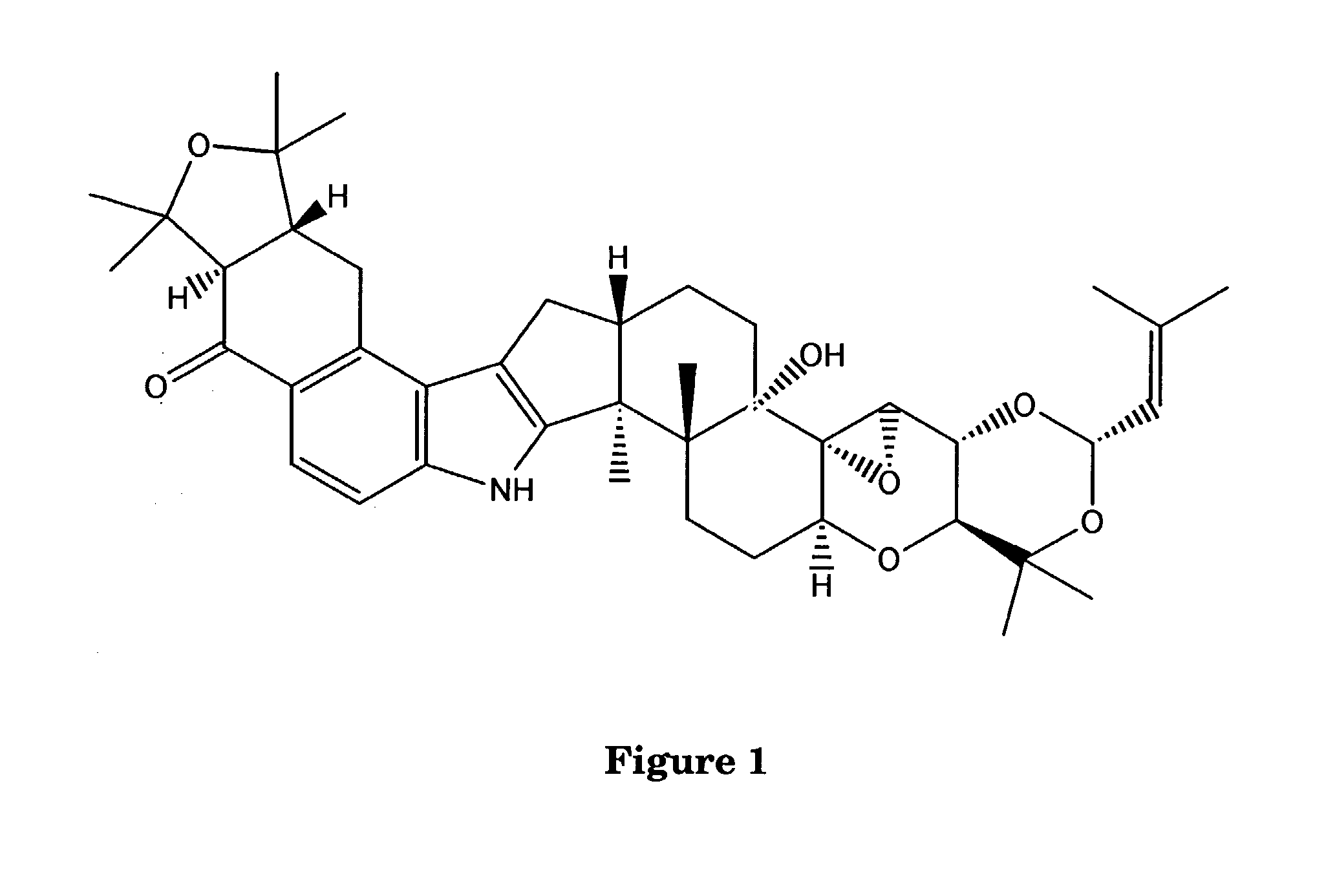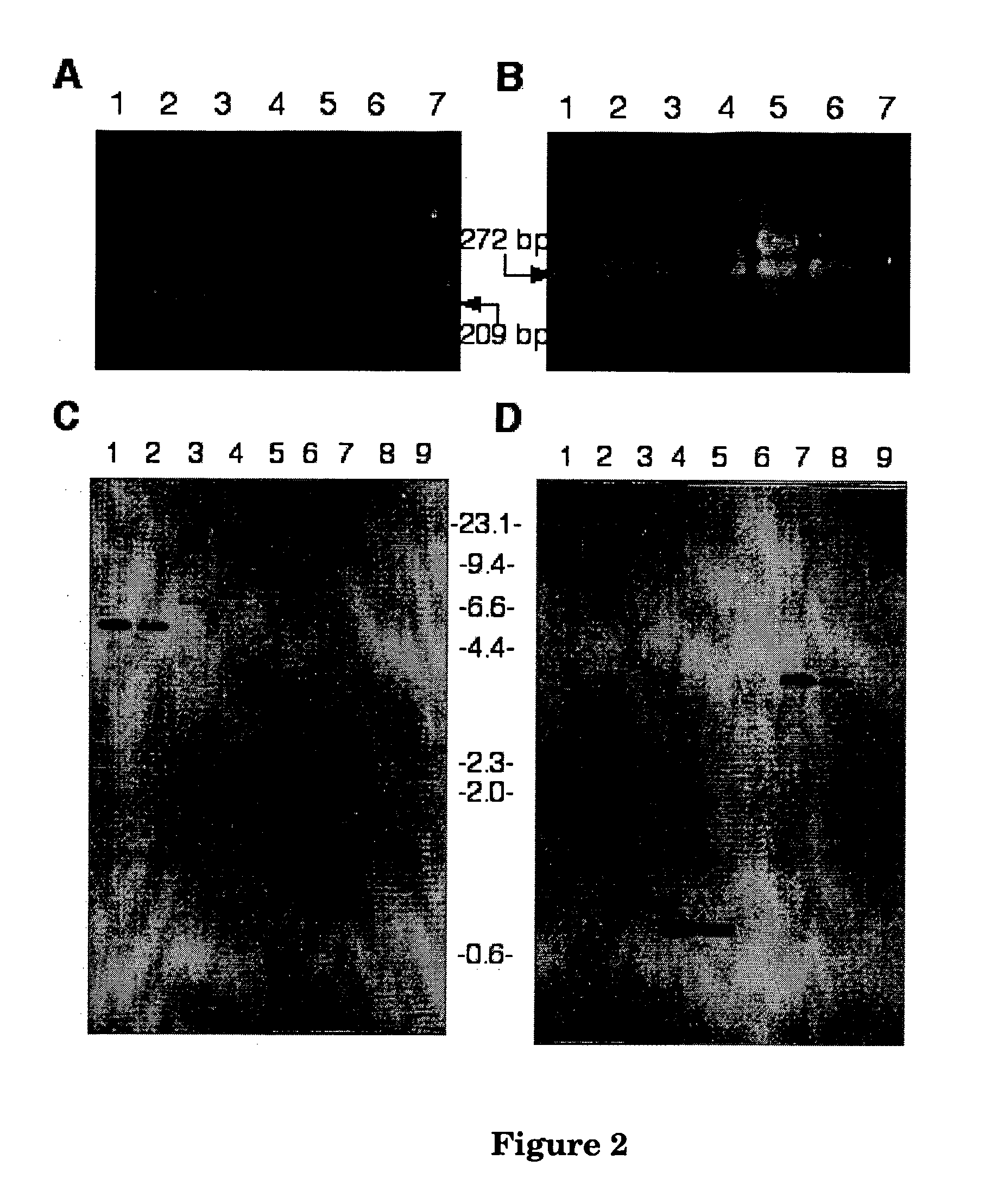Indole-Diterpene Biosynthesis
a technology of indole diterpene and biosynthesis, which is applied in the direction of peptides, plant/algae/fungi/lichens ingredients, enzymology, etc., can solve the problems of further complexity of the carbon skeleton and detrimental to grazing livestock
- Summary
- Abstract
- Description
- Claims
- Application Information
AI Technical Summary
Benefits of technology
Problems solved by technology
Method used
Image
Examples
example 1
Isolation of Nucleic Acid Fragments Containing Homology to GGPP Synthases from N. lolii and E. festucae
[0173] Fungal strains, E. coli strains, plasmids and lambda clones used in this experiment are described in Table 1.
TABLE 1Strains, plasmids, and lambda clones.PNStrainnumberRelevant characteristicsReferenceLp19PN2191Neotyphodium loliiFI1Epichlo{umlaut over (e)} festucaeE8Epichlo{umlaut over (e)} typhinaCYFI1-M28PN2303E. festucae ΔItmM:: hphThis studyCYFI1-M61PN2301E. festucae ΔItmMG:: hphThis studyCYFI1-M142PN2296E. festucae ΔItmM:: hphThis studyCYFI1-M151PN2294E. festucae ΔItmM:: hphThis studyectopic integrationpCB1004AmpR / HygRCarroll et al1994pCY28209 bp ItmG fragment inThis studypGEM-T, AmpRpCY29272 bp ggsA fragment inThis studypGEM-T, AmpRpCY39AmpR / HygR, ItmM KnockoutThis studyconstructpGEM-TAmpRPromegapGEM-T-easyAmpRPromegapPN1688PN1688AmpR / HygRThis studypUC118AmpRThis studyλCY218Lp19λGEM12 containing ItmGThis studyλCY255Lp19λGEM12 containing ItmKThis studyλCY275Lp19λGEM12...
example 2
Isolation of Genomic Fragments Corresponding to ltm Genes
[0191] Using degenerate primers designed to fungal GGPP synthase genes, a fragment of the expected size (Figure2A) was amplified from lolitrem producing strains, Neotyphodium lolii Lp19, and Epichloe festucae Fl1, and from the lolitrem non-producing strain E. typhina E8 lolitrem non-producing strain. P. paxilli genomic DNA was used as a positive control where two fragments of 330 and 270 bp were amplified, corresponding to paxG, with an intron, and ggs1, without an intron (FIG. 2B).
[0192] The LP19 PCR product amplified with primer set ggpps27 and ggpps29 was cloned into pGEM-T easy and sequenced. A BlastX analysis of the CY29 sequence, showed high sequence similarity (E value of 7e-41) to the N. crassa GGPPS (accession number ACC13867) and other GGPPS sequences (Table 4). An RFLP screen of the remaining clones revealed a second unique fragment, CY28, that also showed strong similarity to GGPPS genes (the top score was to P. ...
example 3
Identification of a Gene Cluster for Lolitrem Biosynthesis
[0198] Adjacent to ltmG are two genes, ltmM and ltmK, (FIG. 3) proposed to be a FAD-dependent monooxygenase and cytochrome P450 monooxygenase, respectively. Sequence analysis and characterisation by cDNA analysis of the ltmM gene confirms the presence of three introns (FIG. 3).
[0199] The first two of these introns are conserved with those found in the P. paxilli paxM gene. The third intron is 106 bases, being the largest of the ltm introns confirmed. LtmM is predicted to encode a polypeptide of 472 amino acids with an unmodified molecular weight of 52.5 kDa (Table 4). The nucleotide sequence of N. lolii ltmM and the deduced amino acid sequence of the LtmM polypeptide are shown in FIGS. 6 and 7, respectively. BLASTP analysis showed that LtmM shares 41.0% identity to PaxM from P. paxilli (E value 5e-94). Clustal W alignment (Higgins et al. 1994) of LtmM with PaxM and other closely related polypeptide sequences, identifies the...
PUM
| Property | Measurement | Unit |
|---|---|---|
| temperatures | aaaaa | aaaaa |
| temperatures | aaaaa | aaaaa |
| temperature | aaaaa | aaaaa |
Abstract
Description
Claims
Application Information
 Login to View More
Login to View More - R&D
- Intellectual Property
- Life Sciences
- Materials
- Tech Scout
- Unparalleled Data Quality
- Higher Quality Content
- 60% Fewer Hallucinations
Browse by: Latest US Patents, China's latest patents, Technical Efficacy Thesaurus, Application Domain, Technology Topic, Popular Technical Reports.
© 2025 PatSnap. All rights reserved.Legal|Privacy policy|Modern Slavery Act Transparency Statement|Sitemap|About US| Contact US: help@patsnap.com



